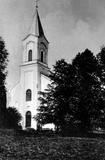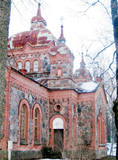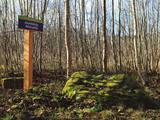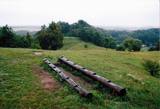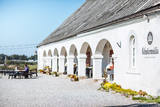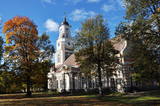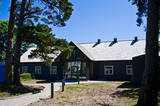| Nr | Name | Beschreibung |
|---|---|---|
|
The first building of the church was built in 1641. The fourth building of the church was only built in 1856 – during the times of Pastor Johann Wilhelm Knierim. Its altar painting – The Crucified Christ (Golgotha) was painted in 1856 by Jozeps Millers, who was influenced by the altar piece in Munich Louis Church created by his teacher Peter Cornelius. An epitaph of Baroness Auguste Amalija von Pistohlkros, the sister of the owner of Bīriņi Manor and the patroness of the church, was immured in the memorial wall. Construction of the tower was completed on 11 June 1856, as evidenced by a memorial plaque on the wall of the church with an inscription “Erbaut von August Pistolkors 1856”. The church was consecrated in 1864. And a year later an organ by Martin Company with 8 registers, which was extended to 14 registers in 1903, was installed in the church. Unfortunately, the organ was destroyed in WW2. Saulkrasti (Pēterupe) Evangelical Lutheran Church survived both World War 2 and the Soviet period. The Soviet era was one of the most difficult times for the church, because many churches in the area were destroyed, pastors were discharged and the congregation fell apart. The Pēterupe congregation remained. As an architectural monument the church was lucky enough to undergo roof repairs of the tower even during Soviet times. Funds were granted by the Chairlady of the Executive Committee Ņina Manzūrova. |
||
|
Die Kirche hat einen 1800 gebauten einzigartigen achteckigen Glockenturm. Blick auf den Lūšiai-See. |
||
|
This is a cemetery that was originated in the Middle Ages and used until the beginning of the 20th century. A mossy stone fence surrounds the cemetery. Interesting elements in the cemetery include the grave of Heinrihs Jakobsons (1832-1911), who was the first schoolteacher in Mazirbe (the old metal cross is to the left of the main gate), a pine tree of national importance and has a circumference of 3.17 metres (during the Soviet Union someone drilled a hole in the trunk of the tree to access honey), the grave of Niks Freimanis (1845-1908), who is said to have been the prototype for a character in a story and play by Marģers Zariņš, and the Werewolf Grave, which relates to countless ghost stories, including the claim that it is the only known gravesite of a werewolf in Latvia. |
||
|
Nītaures vēstures takā var apskatīt un iepazīt dažādus vēsturiskus objektus no 13.gadsimta līdz mūsdienām - seno pilskalnu, vācu ordeņa pilsdrupas, luterāņu un pareizticīgo baznīcas, soda vietu un muižas seno apbūvi. |
||
|
After the death of the Kalnasikšņi oak tree, which was the mightiest tree in the Gauja National Park, the mighty Kvēpene oak tree has taken over that role. It has a circumference of 6.1 m, a height of 20 m, and a crown which measures 28 x 30 m. The beautiful tree is on the right bank of the Gauja River valley and is one of the most excellent trees in Latvia. Near it is the forested Kvēpene castle hill, as is the Svētavots stream, which is reputed to have medicinal waters. To the North of the castle hill is the Rūsiņš hillock, which offers a good view of the surrounding forests, the towers of the city of Cēsis, Ieriķi, and the Rakšupe estuary at the Gauja. There is a bench at the top of the hillock from which lovely sunsets can be seen. |
||
|
Jaunstašuļi Devil's Footstone is situated in the village of Jaunstašuļi in overgrown place beside the
derelict houses. It is hard to find it without the guide. The boulder is 0,75 m high and its circuit is 5,85 m.
On the surface there is the human foot: the length 0,3 m, width 0,09 m, depth 0,02. There was another foot.
It’s obviously scaled off. The North side of the boulder has three casted steps.
|
||
|
In the central part of the Žemaitija Highland, this park was established to protect local landscapes. Lithuania’s highest hillocks are found here – Mėdvegalis (235 m above sea level) and Šatrija (229 m). There are also other hillocks which offer a great view of the area – make up your own tour here.
|
||
|
Der Pfad beginnt bei Kirche von Krimulda. Er führt am Ufer der Runtiņupīte (Runtiņš) bis zur Mündung in die Gauja. Zu besichtigen sind dort das Pfarrhaus, der Burgberg Kubesele, das Denkaml für das Oberhaupt der Liven - Kaupo, die Kubeseler Höhle, der Felsen Saulstaru, der Große Stein, alte Ankerblöcke, Gräberfelder, ein eigenartiges Labyrinth und anderes.
|
||
|
Das Dorf befindet sich 7km nördlich des Zentrums von Vecpiebalga. Hier kann man für die Gegend typische Landhöfe und Handwerkerhäuser des 19.Jh. mit Arbeitsgeräten und Gegenständen des täglichen Lebens besichtigen, auch eine kürzlich erneuerte Windmühle. Im Dorf leben auch heute noch einige Bewohner. Es empfiehlt sich, das Museum mit einem ortskundigen Führer zu besuchen. |
||
|
Befindet sich im Nordteil von Valmiera. Das Herrenhaus des Landguts (im Stil des Neobarocks) wurde vom Herzog Peter August von Schleswig-Holstein-Sonderburg-Beck von 1764 bis1771 gebaut. Später gehörte es anderen verschiedenen Besitzern. Gemäß den heutzutage gefundenen Informationen kann man behaupten, dass das Herrenhaus des Landguts am Anfang des 20. Jahrhunderts ein einstöckiges Gebäude mit einem barockalen Türmchen und einem nebenstehenden zweistöckigen Korpus war. Das Haus diente als Sommer- und Jagdhaus. 1918 wurde das Gebäude verbrannt. Zwei Jahre später wurde im Landgut von Valmiermuiža ein Gefangenenlager eingerichtet. Später wurde den Anbau des Herrenhauses erneuert und als Schule verwendet. 1936 wurde im Gebäude ein Gefängnis eingerichtet, das während des Zweiten Weltkriegs als Haftanstalt der Gefangenen diente. Später wurde das Gebäude verbrannt und die Ruinen abgebaut worden sind. Bis heutzutage ist der Turm von Valmiermuiža erhalten geblieben. Die Deckenmalerei der Turmräume sowie der Park sind Kulturdenkmäler. Heutzutage ist neben dem historischen Ort die Brauerei von Valmiermuiža errichtet und das Landgut von Valmiermuiža hat die zweite Luft bekommen! |
||
|
Die Kirche wurde in der Zeit des Barons Otto Hermann von Vietinghoff von 1781 bis 1788 nach dem Projekt des Architekten Christoph Haberland im Stil des Klassizismus mit barockalen Stilelementen und einem bunten Mosaik aus Feinsplitt an der Fassade des Gebäudes gebaut. Die Kirchenorgel wurde 1855 von Augusts Martins eingerichtet. Die Kirchenglocke wurde während des Ersten Weltkriegs nach Russland gebracht und anstelle dieser Glocke wurde eine 1530 gegossene Glocke aufgehängt. Das Altarbild (der Autor ist unbekannt) “Die Taufe Jesu” ist 2000 erneuert worden. In der Mitte des 19. Jahrhunderts waren in der Gemeinde von Alūksne viele Esten, deswegen wurden die Gottesdienste auch auf Estnisch gehalten. Die Wiederaufbauarbeiten der Kirche wurden 1934 unter der Leitung vom Architekten P. Kampe geführt. Zurzeit ist ein festes Gebäude mit einem 55,5 m hohen Turm eine der Dominanten der Stadt. |
||
|
"Anima Candles" sveces ir roku darbs. Svecēm pieejami vairāki dizaini, kas variē gan krāsās, gan izgatavošanas metodē. Krāsu un smaržu klāsts ir plaši pieejams. Tās izgatavotas no pārtikas rūpniecībā izmantojamā parafīna vai ekoloģiskās sojas. Sveču ražotnē tiek piedāvātas sveču liešanas meistarklases.
|
||
|
Līdz 18. gs. šajā vietā bija koka baznīca, kamēr 1798. g. uzcēla mūra baznīcu, kas cieta 1. pasaules karā, bet 2. pasaules kara laikā to uzspridzināja. Tikai pusgadsimtu vēlāk - 1991. gadā tika uzsākti atjaunošanas darbi, kas joprojām turpinās. Tagad redzamais dievnams ir iepriekšējā līdzinieks. |
||
|
Das Restaurant befindet sich im Hotel Park Hotel Latgola und bietet aus seinem neunten Stockwerk eine weite Aussicht auf die Stadt, sowie lettgallische Gerichte und Gerichte aus der Küche der Welt an. Lettische Küche: Ostseeheringssalat, Salat aus Kümmelkäse, lettgallische Vorspeisen mit Speck, Kartoffel, Käse und eingelegten Gurken, Schweinrippen mit Sauerkraut, Kartoffelpfannkuchen, Kartoffelklöße, Bohnen im Topf, Bratwürste, Quarkfladen. Das besondere Gericht: Krautsuppe mit Steinpilzen. |
||
|
Atpūtas vieta ģimenes īpašumā Vārvē, kurā tiek piedāvāti pirts rituāli. Tāpat ir iespēja pārnakšņot namiņā un atpūsties pie dabas un Ventas upes. |
||
|
The small bar is situated in the city of Madona and there are seating places for 35 people. |
||
|
Matsalu muiža pirmoreiz vēsturiskajos avotos ir minēta 1560. g., kad tā ietilpa Lihulas bīskapijas sastāvā. Tagad redzamās ēkas ir celtas laikā no 18. gs. otrās puses līdz 20. gs. sākumam. Pagājušā gadsimta sešdesmitajos gados te plānoja izveidot Matsalu rezervāta centru, taču „veiksmīgā loze” tika netālu esošajai Penijē muižai (sk. iepriekš). Mūsdienās muižas pils, citas ēkas un parks (tajā dīķis ar salu) atrodas kritiskā stāvoklī. Taču kā nozīmīgu vēstures liecinieku arī šo muižu var iekļaut apskatāmo objektu sarakstā. Muižas komplekss atrodas pa ceļam uz Kēmu (Keemu) putnu vērošanas torni. |
||
|
Pankūku kafejnīca. Dažādi oriģināli pildījumi. Kafejnīca piedāvā svaigi grauzdētu kafiju, kafijas un alkoholiskos dzērienus, kā arī uzkodas. Atvērta tipa virtuve. |
||
|
Livonian Community House at Kolka was opened in 2019. It is a place where you can get to know the Livonian culture of Northern Kurzeme, learn about traditional activities, listen to the sound of the language, and get an idea of the cultural and historical heritage of the coast. In House you can organize and attend cultural events, seminars, trainings, exhibitions, and also receive tourism information. |
||
|
Ein ehemaliges Fischerdorf am Ufer des Kurischen Haffs. Hierher sind die Bewohner der Dörfern umgezogen, deren Dörfe unter dem Sand der Wanderdünen begraben wurden. Holzbebauung des 19 – 20 Jh. |
||
